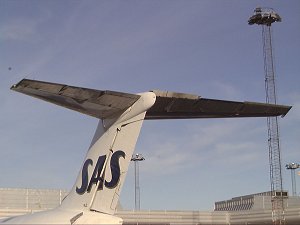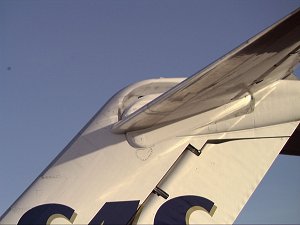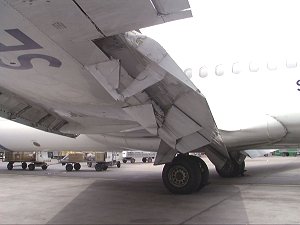PRIMARY CONTROLS are the ailerons, rudder, elevators and horizontal
stabilizer.
The ailerons are aerodynamically operated by control tabs. Should one tab
become inoperative, an override mechanism still permits operation of the opposite
tab. A spring type load feel mechanism provides artificial control forces and
acts as a tab centering device. A lateral spoiler system is provided for additional
lateral control effectiveness.
The rudder is hydraulically powered with automatic reversion to aerodynamic tab control
when hydraulic power is not available. A rudder throw limiter system restricts rudder
travel at high speeds to protect the aircraft from overload caused by excessive rudder
deflection.
The elevators are aerodynamically operated by tabs. Artificial feel is provided by
a load feel and centering mechanism which also assists in returning the control
tabs to a neutral position. A hydraulic power augmentation system assures
aircraft nose-down capability under unusually high angle of attack conditions.
A Mach trim compensator system counteracts any tuckunder tendencies at high
Mach numbers.
The horizontal stabilizer is adjustable for longitudinal trim. It is electrically
operated from either a primary or secondary trim system. All stabilizer operation
is protected by dual trim switches and circuits.
There is no gustlock system as such. Viscous dampers protect the ailerons, the rudder
and the elevators from any flutter tendencies in flight and from damage due to
wind gusts on ground.
SECONDARY CONTROLS include the wing flaps, slats and spoilers.
There is one flap on each wing. The flaps are of double slotted type, hydraulically
operated and mechanically interconnected to assure symmetrical movement.
There are five leading edge slat panels installed in each wing to increase lift
at low speeds. The slats are hydraulically operated.
The spoilers consists of two extendible panels on top of each wing. They aid
the ailerons in lateral control and work as speedbrakes in flight or as ground
spoilers during landing roll. The spoilers are hydraulically operated.

The B elevator with D control tab (moved by the control column) and
C geared tab(mechanically linked to the A horizontal stabilizer).
As the elevator moves, the geared tabs move in the same direction as the control
tabs to provide additional aerodynamic control surface.
|

The right side control tab is seen in full up position. This can often happen
with the aircraft parked and wind from aft.
|

The horizontal stabilizer shown in full nose up trim position.
|

The rudder with control tabs. With hydraulic power available the tabs will be
locked in neutral position.
|

The double slotted wing flaps. The inboard section, located adjacent to the
fuselage, is a triple-slotted flap type. |

Five slat panels are installed on each wing. The slats are either extended or
retracted fully. They will extend by the first movement of the flap handle.
|





